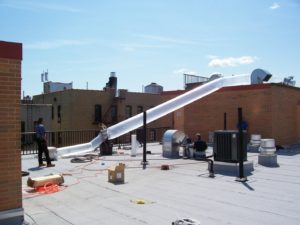- March 31, 2016
- 0 Comments
- In Existing Building Performance
- By Heather Breslin
Earlier this year, at the AHR Expo in Orlando, the biggest trade show for HVAC professionals, Aeroseal’s duct sealing technology was declared the Product of the Year, the top honor of the Innovation Awards. Aeroseal was recognized as “a groundbreaking solution to an industry-wide problem.”
The unique appeal of the Aeroseal technology is that it seals ducts from the inside. Walls and ceilings do not need to be removed or damaged to gain access for traditional mastic sealing. Aerosolized vinyl polymer particles from 2 to 20 micrometers are injected into a pressurized duct system. The particles stay suspended in the air stream until they reach the leaks, where they are deposited and built up at the leak edges until the leaks are sealed.
The Aeroseal technology has been around for more than two decades. It was developed at Lawrence Berkeley National Laboratory in the early nineties and patented in 1997. It has received many awards over the years including the Best of What’s New award from Popular Science magazine in 1996 and the Energy 100 award from the U.S. Department of Energy.
So what’s the big deal?
![]() The most recent award recognizes Aeroseal as a solution for leaky and ineffective ventilation systems. By 2006, the product had been used successfully to seal supply and return space conditioning ducts in over 20,000 homes. The idea to apply the sealing technology to ventilation shafts in multifamily buildings originated with Marc Zuluaga, a mechanical engineer at Steven Winter Associates, Inc. (SWA). Marc approached Carrier, the owner of the Aeroseal technology at the time, with the concept of applying it to multifamily central-exhaust ventilation systems in existing buildings. Through his efforts to reduce energy use in multifamily buildings, Marc had observed first-hand the poor performance and energy penalties associated with leaky, inaccessible central exhaust systems. With Carrier’s support, Marc authored a successful proposal to the New York State Energy and Research Development Authority (NYSERDA).
The most recent award recognizes Aeroseal as a solution for leaky and ineffective ventilation systems. By 2006, the product had been used successfully to seal supply and return space conditioning ducts in over 20,000 homes. The idea to apply the sealing technology to ventilation shafts in multifamily buildings originated with Marc Zuluaga, a mechanical engineer at Steven Winter Associates, Inc. (SWA). Marc approached Carrier, the owner of the Aeroseal technology at the time, with the concept of applying it to multifamily central-exhaust ventilation systems in existing buildings. Through his efforts to reduce energy use in multifamily buildings, Marc had observed first-hand the poor performance and energy penalties associated with leaky, inaccessible central exhaust systems. With Carrier’s support, Marc authored a successful proposal to the New York State Energy and Research Development Authority (NYSERDA).
With funding from NYSERDA, SWA and Carrier researchers demonstrated the concept in several New York City multifamily buildings in 2007, and again in 2008 in an Albany, NY, building with many observers. The technology is now routinely used in NYC multifamily buildings.
“For decades now, the problems associated with poor building ventilation were all but ignored for one simple reason – there really wasn’t a viable solution,” said Aeroseal Senior Vice President, Neal Walsh. “Now, it’s possible to seal the leaks that are typically the root cause of poor building ventilation and to do so in an economical, non-invasive manner – and that is proving to be a real game changer for building professionals.”
It has been over twenty years since the product was developed, ten since its application for multifamily buildings was first uncovered, and it is only now that Aeroseal is being publicly recognized with the Innovation Award for Product of the Year. What’s the takeaway? Things take time. Guiding the product from inception through peer review and research, to wide-spread adoption and recognition was not a quick process. In the building science industry that is often the case, but if the product is a strong one, as in the case of Aeroseal, it can ultimately become something that shapes industry best practices going forward.
SWA researchers continue to seek ways to improve the performance of new and existing multifamily buildings. Current NYSERDA-funded research projects are:
- Demonstrating and evaluating supply-side orifice plates in multifamily buildings with two-pipe steam distribution systems
- Testing and verifying the performance benefits of linkageless burner controls and flue draft regulators as retrofit measures on intermediate-sized (100 – 500 HP) steam boiler plants
- Investigating the use of building –integrated batteries for multifamily peak-load reduction, resiliency, and demand response

